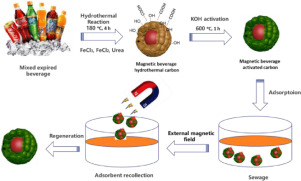Journal of the Taiwan Institute of Chemical Engineers ( IF 5.5 ) Pub Date : 2018-11-24 , DOI: 10.1016/j.jtice.2018.11.017 Yunjie Liu , Zhibao Huo , Zhiyuan Song , Chuntao Zhang , Dezhang Ren , Heng Zhong , Fangming Jin

|
The purpose of this study is to prepare a magnetic activated carbon by KOH activation using expired beverage of several brands as raw material. The maximum adsorption capacity of MBAC for MB (Methylene blue) at 298 K was 404.73 mg/g, could be recycled for 3 times, this study achieved a dual purpose of resource reuse and beverage wastewater treatment. The preparation of activated carbon was divided into two stages: the hydrothermal treatment and activation process. Before and after the hydrothermal treatment, the content of fructose, sucrose, glucose in expired beverages was tested by High Performance Liquid Chromatography (HPLC), it indicated that under the same reaction condition (4 h, 180 °C, 20 mL), the fructose can be converted to hydrothermal carbon much easier than that of sucrose and glucose. According to the data obtained from TOC (total organic carbon) analyzer, the removal rate of 71.6% of organic matters from the beverage can be achieved in 4 h after the hydrothermal treatment. In terms of the activation process, an activated carbon with a specific surface area of 1237 m2/g and pore size of 2.05 nm could be achieved; the XRD and magnetization analysis confirmed the Fe3O4’s crystal structure was preserved and the saturation magnetization of MBAC (magnetic beverage activated carbon) was 12.4 emu/g after the activation process. To describe the adsorption process, the pseudo-second-order and Langmuir model was more suitable.
中文翻译:

以过期饮料为碳源,KOH为活化剂制备磁性活性炭
这项研究的目的是通过使用几种品牌的过期饮料为原料,通过KOH活化来制备磁性活性炭。在298 K时,MBAC对MB(亚甲基蓝)的最大吸附容量为404.73 mg / g,可重复使用3次,从而达到了资源再利用和饮料废水处理的双重目的。活性炭的制备分为两个阶段:水热处理和活化过程。在水热处理之前和之后,通过高效液相色谱(HPLC)检测过期饮料中果糖,蔗糖,葡萄糖的含量,结果表明在相同的反应条件(4 h,180°C,20 mL)下,果糖可以比蔗糖和葡萄糖转化为水热碳容易得多。根据从TOC(总有机碳)分析仪获得的数据,在水热处理后4小时内,可以从饮料中去除71.6%的有机物。就活化过程而言,比表面积为1237 m的活性炭2 / g,孔径为2.05 nm;XRD和磁化分析证实,活化过程后,Fe 3 O 4的晶体结构得以保留,MBAC(磁性饮料活性炭)的饱和磁化强度为12.4 emu / g。为了描述吸附过程,拟二阶和Langmuir模型更合适。











































 京公网安备 11010802027423号
京公网安备 11010802027423号